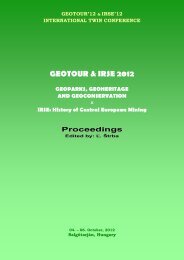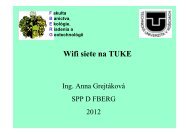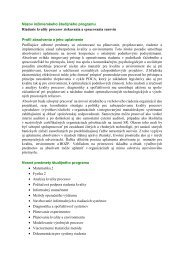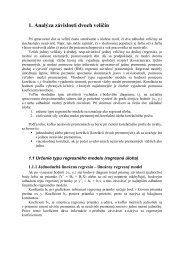GEOTOUR & IRSE 2012.pdf - Fakulta BERG - TUKE
GEOTOUR & IRSE 2012.pdf - Fakulta BERG - TUKE
GEOTOUR & IRSE 2012.pdf - Fakulta BERG - TUKE
You also want an ePaper? Increase the reach of your titles
YUMPU automatically turns print PDFs into web optimized ePapers that Google loves.
Salgótarján, 04. – 06. October 2012<br />
assumed that the sink side of István lápai cave might be discovered from the Szepesi-Láner<br />
cave system, and the spring side from the Szent István cave, as soon as speleologists find<br />
these connecting passages.)<br />
Shaft caves<br />
There aren‟t many shaft caves (vertical, mostly open) in the Bükk. Of the few, the Kis-kőháti<br />
shaft cave must be mentioned where we can reach a huge spectacular chamber through the<br />
entrance shaft. The Szeleta shaft cave, Bányász cave and Hársas shaft cave belong to the same<br />
category as well.<br />
Cave ruins (rock arches and natural bridges)<br />
The various size and length cave ruins are wonderfully spectacular sights. They can be formed<br />
by external forces (water, wind, gravitation) in many different positions. The stone rib of<br />
Ablakos-kő („Window Rock‟) has basically got a hole in its middle, thus making a formation<br />
after which it has got its name. The „natural‟ entrance of the above mentioned Udvar-kő<br />
precipice dolina is the rock bridge called Sziklakapus sinkhole. The Háromkúti-nagysziklakapu<br />
(rock arch) is a rock formation, but the Büdöspest and the Suba-lyuk are cave<br />
passage sections, opened at both ends.<br />
Spring caves<br />
Water exits from a number of caves even today, and based on morphological and<br />
hydrogeological characteristics of the caves, it can be safely assumed that water used to exit<br />
from them at one time. The first group includes the Kecske-lyuk, the Szent István cave, and<br />
the Imó spring cave. The latter groups includes the Szeleta cave, Istállós-kői cave, Hillebrand<br />
Jenő cave, Balla cave, etc. (These last ones are also significant from the Bükk‟s<br />
archaeological point of view, with regards to palaeolithic age humans.) The Szent István cave<br />
is a tourist cave as well as a medicinal cave. The Miskolctapolca Tavas cave encompasses the<br />
cave spa and bath.<br />
Sinter caves<br />
So far we‟ve been discussing postgenetic caves, i. e. when first the rock that later<br />
encompassed the cave had been formed, and later the cave came into existence. In case of<br />
sinter caves, the formation of the rock encompassing the cave and the formation of the cave<br />
itself happens basically at the same time. For this reason the caves formed in sinter are called<br />
syngenetic caves. The more significant sinter caves of the Bükk were formed in the sinter<br />
deposit of the Szinva valley, and these are the Anna sinter cave, the Soltész-kerti cave and the<br />
Soltész shaft, which were discovered and explored by mining methods. (A section of Anna<br />
sinter cave operates as tourist cave.) There used to be sinter mining close to Mónosbél at one<br />
time. This probably have destroyed many sinter caves.<br />
Not enclosed cold water springs<br />
There are over 1000 springs located in the Bükk mountains with various yields, exiting<br />
various types of rocks at different levels above sea level. The not enclosed springs (i. e. the<br />
water leaves the spring in a natural way, no human made structures built onto the spring) are<br />
usually small and seasonal, but a number of them can be considered permanent. The<br />
Eszperantó spring exits dolomite, the Disznós creek and Létrási creek exits shale, the<br />
Soltészkerti spring exits sinter, and the Imó spring exits limestone.<br />
Enclosed cold water springs for tourists<br />
A significant number of larger springs are for tourist use (for instance the Mária spring,<br />
Bársonyos spring, Wekerle spring, Tamás well, Vörös-kői seasonal spring, Sólyom well,<br />
76
















